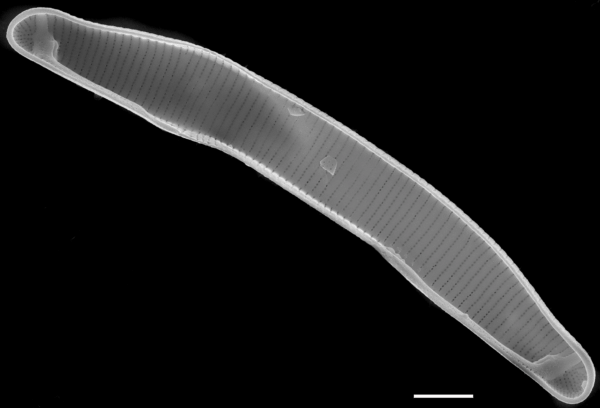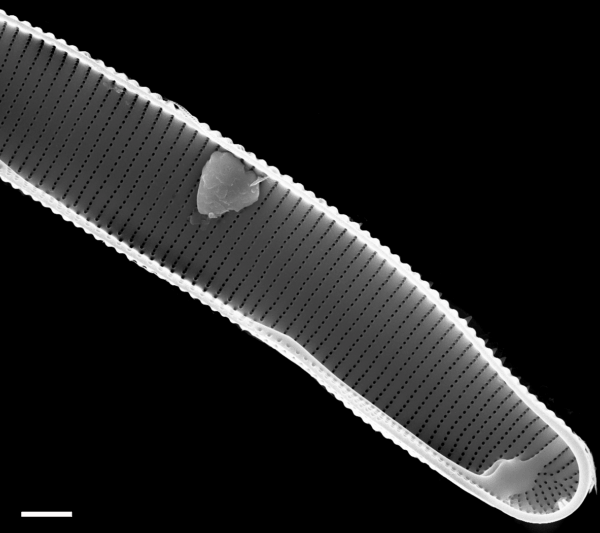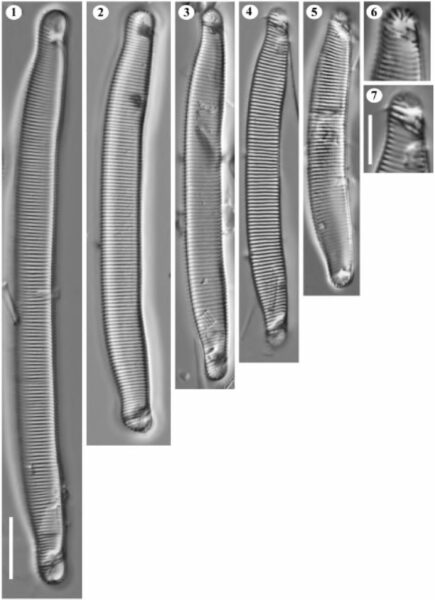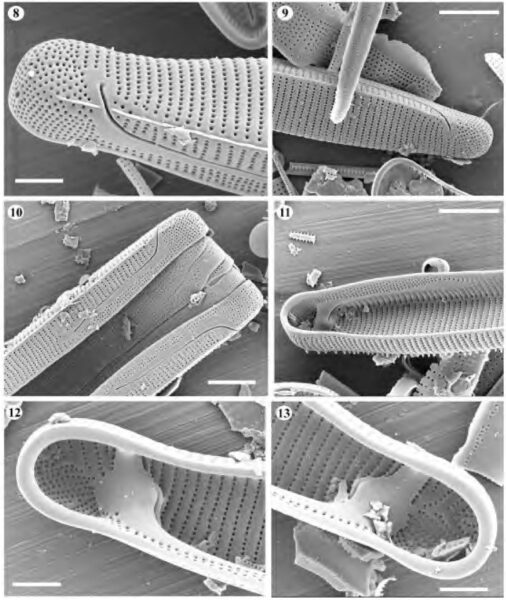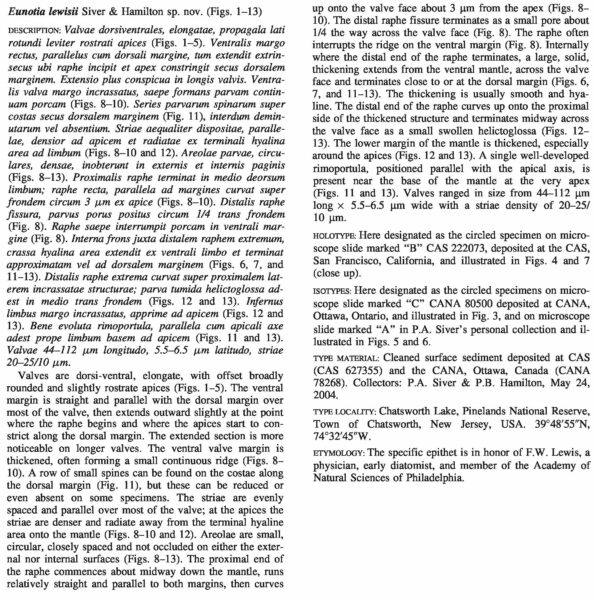Eunotia lewisii
-
Category
-
Length Range35-107 µm
-
Width Range5.2-6.8 µm
-
Striae in 10 µm18.0-19.5
-
ContributorJen Beals - Feb 2012
-
ReviewerSarah Spaulding - Apr 2012
Identification
Description
Valves are depressed on the ventral margin between the proximal raphe fissures. The dorsal margin is parallel to ventral margin, becoming slightly convex on shorter valves. Small spines are present along the dorsal margin, extending to the valve apices, but the spines are not distinguishable under LM. Valve apices are rostrate. Striae are regularly spaced and parallel, except at the apices where they become radiate distal to the terminal raphe fissures. Striae continue across the mantle. Areolae are small, circular and evenly spaced, 40-44 in 10 µm. The proximal raphe originates close to the mantle margin and continues straight on the ventral mantle, curving strongly across the valve apices towards the dorsal margin. Internally, the raphe terminates with prominent helictoglossae that are set in a thickened ridge continuing to the dorsal margin. One rimoportula is present near the base of the mantle at valve apex, parallel with the apical striae.
Note: Stria density in the original description was erroneously reported as 20-25 in 10 µm. Stria density of isotype specimen is 18 in 10 µm (per P. Hamilton).
Autecology
Only known from moderately acidic ponds and lakes.
-
Size Range, µm3
-
Motility
-
Habitat
-
Colony
-
Waterbody
- Learn more about this
Original Description
Valves are dorsi-ventral, elongate, with offset broadly rounded and slightly rostrate apices (Figs. 1–5). The ventral margin is straight and parallel with the dorsal margin over most of the valve, then extends outward slightly at the point where the raphe begins and where the apices start to constrict along the dorsal margin. The extended section is more noticeable on longer valves. The ventral valve margin is thickened, often forming a small continuous ridge (Figs. 8–10). A row of small spines can be found on the costae along the dorsal margin (Fig. 11), but these can be reduced or even absent on some specimens. The striae are evenly spaced and parallel over most of the valve; at the apices the striae are denser and radiate away from the terminal hyaline area onto the mantle (Figs. 8–10 and 12). Areolae are small, circular, closely spaced and not occluded on either the external nor internal surfaces (Figs. 8–13). The proximal end of the raphe commences about midway down the mantle, runs relatively straight and parallel to both margins, then curves up onto the valve face about 3 µm from the apex (Figs. 8–10). The distal raphe fissure terminates as a small pore about 1/4 the way across the valve face (Fig. 8). The raphe often interrupts the ridge on the ventral margin (Fig. 8). Internally where the distal end of the raphe terminates, a large, solid, thickening extends from the ventral mantle, across the valve face and terminates close to or at the dorsal margin (Figs. 6, 7, and 11–13). The thickening is usually smooth and hyaline. The distal end of the raphe curves up onto the proximal side of the thickened structure and terminates midway across the valve face as a small swollen helictoglossa (Figs. 12–13). The lower margin of the mantle is thickened, especially around the apices (Figs. 12 and 13). A single well-developed rimoportula, positioned parallel with the apical axis, is present near the base of the mantle at the very apex (Figs. 11 and 13). Valves ranged in size from 44–112 µm long x 5.5–6.5 µm wide with a striae density of 20–25/ 10 µm.
-
AuthorSiver and Hamilton 2009
-
Length Range44-112 µm
-
Width5.5-6.5 µm
-
Striae in 10µm20-25
Citations & Links
Citations
-
Publication Link: 10.1080/0269249X.2009.9705802
-
Publication Link: doi:10.1139/B09-015
Links
-
Index Nominum Algarum
-
North American Diatom Ecological DatabaseNADED ID: 33370
Cite This Page
Beals, J. (2012). Eunotia lewisii. In Diatoms of North America. Retrieved April 25, 2024, from https://diatoms.org/species/eunotia_lewisii
Responses
The 15 response plots show an environmental variable (x axis) against the relative abundance (y axis) of Eunotia lewisii from all the stream reaches where it was present. Note that the relative abundance scale is the same on each plot. Explanation of each environmental variable and units are as follows:
ELEVATION = stream reach elevation (meters)
STRAHLER = distribution plot of the Strahler Stream Order
SLOPE = stream reach gradient (degrees)
W1_HALL = an index that is a measure of streamside (riparian) human activity that ranges from 0 - 10, with a value of 0 indicating of minimal disturbance to a value of 10 indicating severe disturbance.
PHSTVL = pH measured in a sealed syringe sample (pH units)
log_COND = log concentration of specific conductivity (µS/cm)
log_PTL = log concentration of total phosphorus (µg/L)
log_NO3 = log concentration of nitrate (µeq/L)
log_DOC = log concentration of dissolved organic carbon (mg/L)
log_SIO2 = log concentration of silicon (mg/L)
log_NA = log concentration of sodium (µeq/L)
log_HCO3 = log concentration of the bicarbonate ion (µeq/L)
EMBED = percent of the stream substrate that is embedded by sand and fine sediment
log_TURBIDITY = log of turbidity, a measure of cloudiness of water, in nephelometric turbidity units (NTU).
DISTOT = an index of total human disturbance in the watershed that ranges from 1 - 100, with a value of 0 indicating of minimal disturbance to a value of 100 indicating severe disturbance.
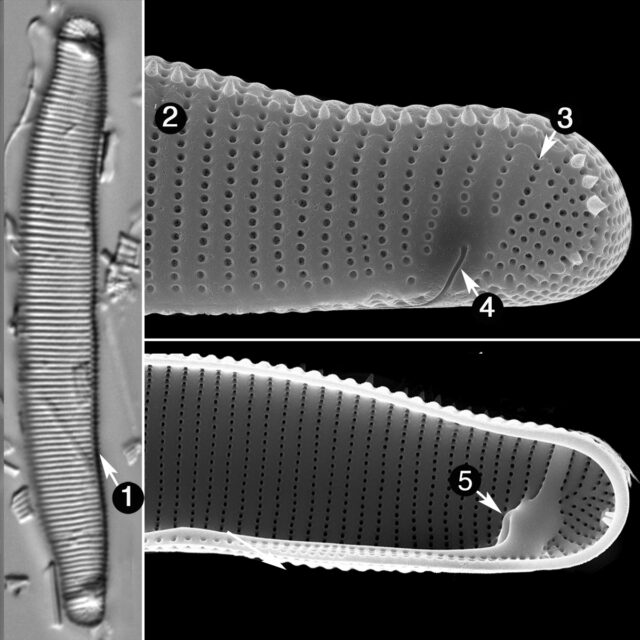
Eunotia lewisii
- Ventral margin depressed between proximal raphe ends
- Stria density consistent
- Striae radiate distal to the terminal raphe ends
- Terminal raphe ends cross the valve face near the apices
- Helictoglossae prominent
The ventral margin is depressed between the proximal raphe ends; the dorsal margin is flat and parallel to the ventral margin. Apices are rostrate. Striae are evenly spaced and parallel, becoming radiate distal to the terminal raphe ends. The raphe curves across the valve face at the apices, with a prominent helictoglossa and a thickened...
 Diatoms of North America
Diatoms of North America






